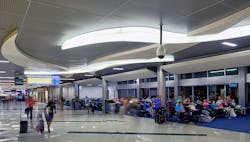When JE Dunn Construction took on a large-scale renovation project inside the domestic terminal of “the world’s busiest and most efficient airport” — Hartsfield-Jackson Atlanta International Airport — the project team confronted an array of policies, procedures, protocol and moving parts.
Hartsfield-Jackson’s multi-faceted, 24-hour operation daily accommodates 63,000 on-site jobs, 2,700 arriving and departing flights, and 275,000 passengers.
“This project took an extreme amount of coordination with an extreme number of stakeholders,” recalled Senior Project Manager Nick Christoffersen.
The project team was also bound by an inviolable commandment: work must minimally impact airport and airline operations. “Pardon our progress” did not apply.
Enhancing operations and customer care
Hartsfield-Jackson is pursuing a 20-year, multi-billion-dollar expansion and modernization program, including improvements to the Central Passenger Terminal Complex.
One project of the transformation involved upgrading 85 gate hold rooms and adjacent corridor areas in Concourses T, A, B and C. The project also consisted of modernizing the boarding level midpoints at Concourses T, A and B.
The two-year, $112.7 million contract to recast and brighten up the hold rooms included removing existing storefront systems and portions of exterior metal panels to install floor-to-ceiling glass, upgrade lighting, replace flat acoustical ceilings with sloped metal ceiling panels, install new carpet and repaint the hold rooms.
JE Dunn had previously completed millions of dollars in project work at Hartsfield-Jackson and was used to navigating such processes as obtaining security clearances for each worker and gaining approval of all logistics plans, including the movement and securing of tools and equipment.
However, the hold room renovations would be the most complex project to date for Dunn Aviation Group, a Joint Venture team comprising JE Dunn, Enviro AgScience and Southeastern Engineering. Sprawled across multiple corridors, the job would require heightened levels of orchestration and teamplay.
“From the moment we got all of our trade partners signed up, we immediately began holding coordination meetings,” Christoffersen said.
Timing is everything
As one approach to promoting efficient scheduling and workflow, the team used a bedrock strategy from its project-delivery playbook, the lean construction practice of pull planning. A technique of the Last Planner System, pull planning affirms the inter-dependence of all tasks and activities. Working backward from the target completion date, stakeholders come together to identify project milestones and the activities required to reach them. The process rallies the collective expertise of trade partners in a collaborative approach to problem-solving and scheduling.
The renovations took place during overnight hours — from 10 p.m. to 5 a.m. Critically, a day team facilitated the nocturnal construction work by nailing down many of the planning details.
“Unlike during the day, when we could call suppliers about, say, late deliveries, that wasn’t possible at 1 o’clock in the morning,” said Christoffersen. “More planning and coordination had to happen to ensure that all necessary equipment and materials were either on a trailer or in a warehouse close to the airport or staged in areas where we would be working.”
Project tasks had to harmonize with a host of airport departments, functions and activities: security, airline operations, control tower, concessions, information technology, maintenance as well as other contractors working on site.
For any system to be taken out of service — from sprinklers to major utilities — the project team was required to submit shut-down requests three weeks prior to that work commencing.
Aware that on any particular day and with any of the targeted hold rooms, circumstances beyond their control — arriving flights delayed by extreme weather, for example — could undermine meticulously created shift plans, project managers typically built into schedules the flexibility to assign crews to other areas or activities. There were occasions, though, when work had to be cancelled and make-up shifts scheduled.
Every Friday, the project superintendent emailed the air traffic control tower a list of hold rooms slated for renovation the following week, ensuring that the construction schedule did not conflict with any airport/airline operations.
At 9 p.m. every evening, the superintendent called the tower to confirm that designated hold rooms were cleared for workers to move in. If exterior work was scheduled, the superintendent made sure that no planes would be parked on aprons outside terminal gates where work was planned.
Work in progress
A green light from the tower set crews in motion. Work-zone barricades were positioned, passenger seats and gate agent counters were removed, scissor lifts rolled in and safety spotters posted. As work proceeded, a new ambiance took form.
Late night was also when airport businesses cleaned, re-stocked and prepared for the next day. So construction teams needing access to mechanical or electrical systems around restaurants, gift shops and specialty retailers intersected cooperatively with the concessionaires.
Meanwhile, cleaning crews and airline and airport employees moved about the periphery of the construction zones, as did passengers using neighboring gates still in service.
At the height of the activity, 250 to 400 workers were busy remodeling rooms on all four concourses. With lean construction’s emphasis of continuous improvement, the project team periodically held retrospective meetings to review lessons learned and adopt work-smarter methods. One adjustment involved creating staging areas where trade partners could conveniently and safely store several days’ worth of materials. Another change involved working from north to south along a corridor, rather than end-to-center. The new approach proved better for streamlining the work and its sequencing.
For the duration of the project, which entailed 592,000 total man hours, construction did not cause any unplanned impact to any of the 85 hold rooms, and the project’s safety performance, as expressed by OSHA’s Total Recordable Incident Rate was .7 (a TRIR of 3.0 or less is considered good).
The project won the Construction Management Association of America South Atlantic Chapter’s Top Transportation Project with a construction value greater than $100 million, as well as 2019 Project of the Year.
The project team didn’t just succeed in being inconspicuous and achieving superior schedule, budget and safety performance.
“We were an integral part of promoting a positive passenger experience,” explained Vice President/Aviation Project Executive Iana Tassada. “If you were wearing a hard hat or a safety vest, you automatically served as a customer service representative.”
Maintaining a friendly, approachable bearing, answering questions and giving directions came with the territory.
“We reminded our teams often about being courteous and helpful — going above and beyond to provide that extra assistance,” Tassada said. “Actually, passengers approached us a lot — and we met the challenge.”
Renovation work typically wound down an hour before quitting time so crews could dust, vacuum, touch-up paint, tuck loose wiring, restore appropriate lighting levels, put back furniture, re-assemble dismantled systems and stow away tools and materials.
Workers vacated hold rooms by 5 a.m. — presenting to daytime airline personnel and passengers a neat, finished appearance to a yet unfinished project.
Christoffersen said, “Each day, our mandate was to get the work done, leave and have it appear as if we were never on site.”
Nick serves as a senior project manager for JE Dunn Construction’s Atlanta division. He has been instrumental in the success of the company’s entrance into the aviation market, including helping secure and manage projects for the City of Atlanta Department of Aviation, Atlanta Airlines Terminal Corporation (AATC) and Delta Air Lines.
Nick has been with JE Dunn since 2013 and has 13 years of experience in commercial construction. He holds a Bachelor of Science degree in Construction Management from Georgia Southern University. He is OSHA 30-hour as well as CPR trained.
In his spare time, Nick enjoys golfing, boating, a wide variety of fitness activities and attending all types of sporting events. He currently resides in Woodstock, GA, with his wife Kimberly, their two year-old son, Hudson, and goldendoodle, Murphy





